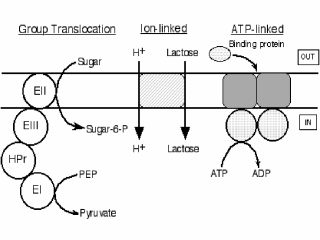 |
Figure 6. Different types of active transport
systems. Left, the phosphoenolpyruvate carbohydratephosphotransferase
system, found in bacteria only, is a multi-component system that catalyzes
vectorial phosphorylation of certain sugars. Also plays important role in
regulation of metabolism (catabolite repression). Middle, lac permease, an
example of ion-gradient driven active transport on which we will
concentrate. Right, ATP Binding Cassette (ABC) systems in which ATP
hydrolysis is the driving force for transport. May function as
multi-component systems with a periplasmic binding protein or with
components fused in different combinations. These bacterial transport
ATPases are homologous to eucaryotic ABC transporters involved in cystic
fibrosis (CFTR) and multi-drug resistance (MDR).
|
